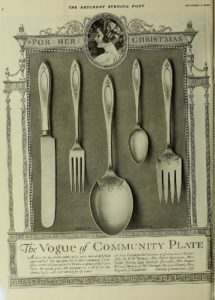Edward T. Howe
Wallingford, located about twenty miles southwest of Hartford along the Quinnipiac River, was once home to a small branch of the Oneida Community. The Oneida Community was a religious cooperative group with shared beliefs, founded in 1848 in Oneida, New York, by John Humphrey Noyes—a radical utopian socialist. Throughout its existence, the community remained economically self-sufficient. More significantly, during its later years, the Wallingford commune was an important original site for silverware production.
The Wallingford commune, established on the western side of town in 1851 on farmland donated by Henry and Emily Allen, also became a recreational and educational retreat for its members. It had a small population during its existence that ranged from seventeen (at its beginning) to about fifty members before it closed. Their religious beliefs focused on Perfectionism, an attempt by its members to establish an earthly paradise through enhancing the welfare of others. Various practices included: the idea of complex marriage, where consensual sexual relations were permitted (free love); male continence regarding sex; stirpiculture (eugenics) or the breeding of children with special characteristics; significant changes in the role of women (e.g., communal childcare and participation in community activities); and the sharing of all possessions and resources.
Initially the Wallingford branch supported itself through agriculture. It used its property for grazing and for growing and preserving small fruits such as strawberries, raspberries, and grapes. Realizing that agriculture was insufficient to sustain them financially, they turned to industrial pursuits.
The Wallingford Community Turns to Manufacturing
In 1852, they began making carpet and lunch bags. The manufacture of chains for steel animal traps followed in 1857. The printing business—mainly The Circular, Wallingford’s first newspaper—returned to Oneida in 1868. A year later, the Wallingford community bought a factory to make silk thread and ribbons. Despite adverse economic conditions in the 1870s, the Wallingford commune started producing tin-plated spoons (silverware) in 1877.
In the late 1870s, growing dissension over its beliefs resulted in the dissolution of both the Oneida and Wallingford communes in 1880. A joint-stock company, Oneida Ltd. quickly assumed its business interests, however. The company (owned by commune members through proportional shares) moved its various businesses to Niagara Falls within two years. The Wallingford commune property was sold to the Freemasons in 1894 as a home for its elderly members.
Between 1912 and 1914, the profitable cutlery business shifted to Sherrill, New York. Meanwhile, the firm divested its unprofitable animal trap business in 1912, its silk business in 1913, and its fruit canning operation in 1916.
The silverware business continued to prosper domestically and internationally throughout the twentieth century. Unfortunately, the company, known as Oneida Limited after 1935, encountered difficult economic times as the twenty-first century unfolded. Several of its business operations had to be sold, including its manufacturing facilities in Sherrill in 2005.
Edward T. Howe, Ph.D., is Professor of Economics Emeritus at Siena College near Albany, New York.










